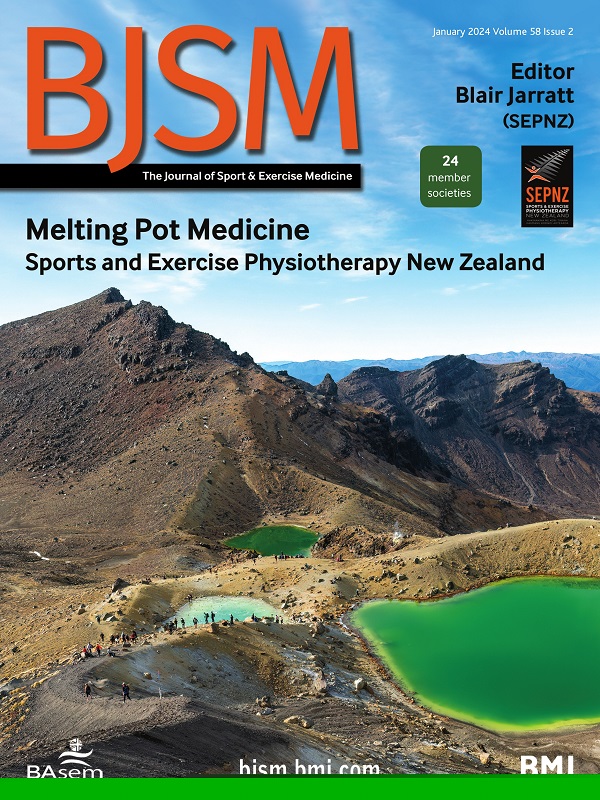Role of video review for sport-related concussion identification: a systematic review
IF 16.2
1区 医学
Q1 SPORT SCIENCES
引用次数: 0
Abstract
Objective To determine the frequency and diagnostic utility of visible signs identified through video review for sport-related concussion detection and to evaluate the role of injury mechanism in predicting concussions. Design Systematic review. Data sources MEDLINE, SPORTDiscus, Web of Science and Cochrane Library from 2001 to June 2024. Eligibility criteria Original, peer-reviewed studies focusing on sport-related concussion, where video review identified visible signs or the mechanism of injury relevant to clinical decision-making. Studies were included irrespective of study design but had to be published in English and use a clinical diagnosis or consensus definition of sport-related concussion as a reference standard. Results Out of 1001 records screened, 29 studies involving 3281 sport-related concussions were included for quantitative synthesis. Only eight studies had a low risk of bias. All studies used clinical diagnosis as a reference standard; 26 were conducted in professional competitions, with two studies including female athletes. The most frequently observed visible sign was ‘slow to get up’ (37.6%), followed by ‘motor incoordination’ (26.7%). Sensitivity of visible signs was generally low (<50%), while specificity was high (>90%) across most studies. Four studies across three sports examined mechanism of injury characteristics, identifying common themes, such as high speed of impact, potentially associated with sport-related concussion occurrence. Inter-rater and intrarater reliability varied, with indications of higher reliability among expert raters. Conclusions Expert video review can reliably identify visible signs of sport-related concussion. However, due to their low frequency and limited diagnostic sensitivity, the diagnosis of sport-related concussion should be supported by a multimodal assessment. All data relevant to the study are included in the article or uploaded as supplementary information.视频回顾在运动相关脑震荡识别中的作用:系统回顾
目的探讨视频影像在运动相关脑震荡检测中的频率和诊断价值,并探讨损伤机制在预测脑震荡中的作用。设计系统评审。数据来源MEDLINE, SPORTDiscus, Web of Science和Cochrane Library从2001年到2024年6月。入选标准:针对运动相关脑震荡的原创、同行评议的研究,通过视频审查识别出与临床决策相关的可见迹象或损伤机制。无论研究设计如何,研究都被纳入,但必须以英文发表,并使用临床诊断或运动相关脑震荡的共识定义作为参考标准。结果在筛选的1001份记录中,纳入了29项研究,涉及3281例运动相关脑震荡,用于定量综合。只有8项研究的偏倚风险较低。所有研究均以临床诊断为参考标准;在职业比赛中进行了26项研究,其中两项研究包括女运动员。最常见的可见症状是“起床缓慢”(37.6%),其次是“运动不协调”(26.7%)。在大多数研究中,可见体征的敏感性普遍较低(90%)。涉及三种运动的四项研究考察了损伤特征的机制,确定了共同的主题,如高速撞击,可能与运动相关的脑震荡发生有关。评价者之间和评价者内部的信度各不相同,有迹象表明专家评价者的信度较高。结论专家视频检查可以可靠地识别运动相关脑震荡的可见迹象。然而,由于它们的低频率和有限的诊断敏感性,运动相关脑震荡的诊断应该通过多模式评估来支持。所有与研究相关的数据都包含在文章中或作为补充信息上传。
本文章由计算机程序翻译,如有差异,请以英文原文为准。
求助全文
约1分钟内获得全文
求助全文
来源期刊
CiteScore
27.10
自引率
4.90%
发文量
217
审稿时长
3-8 weeks
期刊介绍:
The British Journal of Sports Medicine (BJSM) is a dynamic platform that presents groundbreaking research, thought-provoking reviews, and meaningful discussions on sport and exercise medicine. Our focus encompasses various clinically-relevant aspects such as physiotherapy, physical therapy, and rehabilitation. With an aim to foster innovation, education, and knowledge translation, we strive to bridge the gap between research and practical implementation in the field. Our multi-media approach, including web, print, video, and audio resources, along with our active presence on social media, connects a global community of healthcare professionals dedicated to treating active individuals.

 求助内容:
求助内容: 应助结果提醒方式:
应助结果提醒方式:


